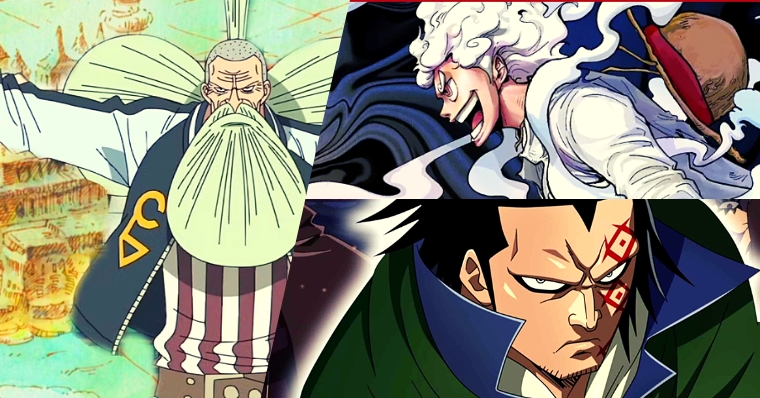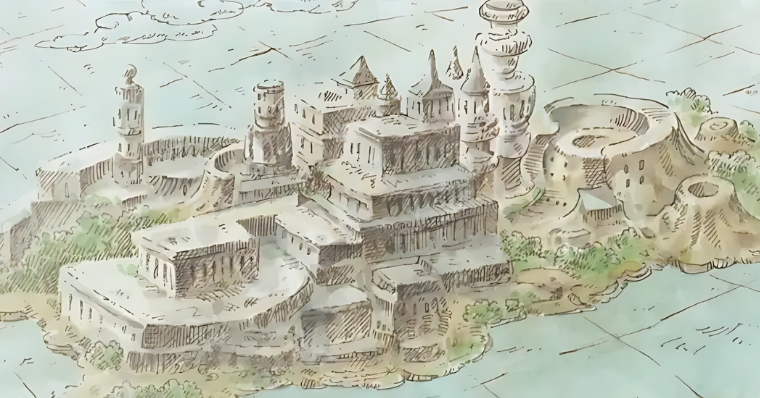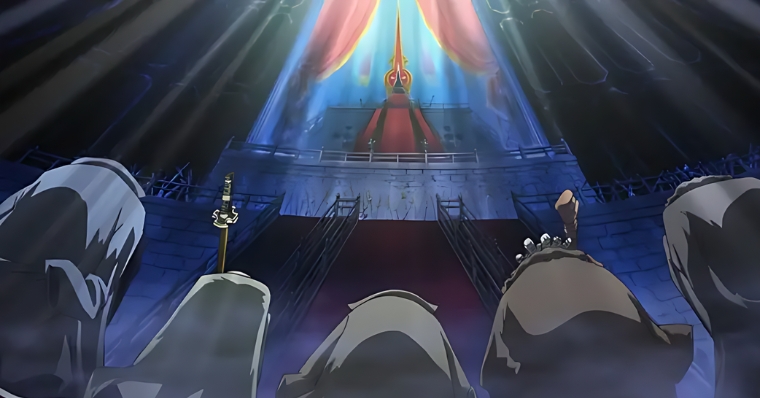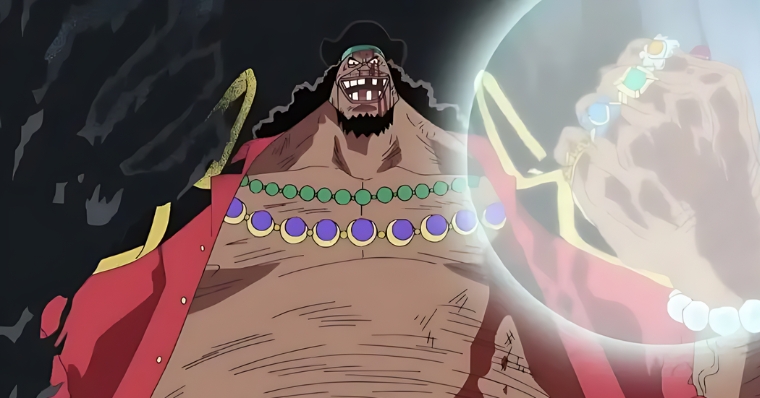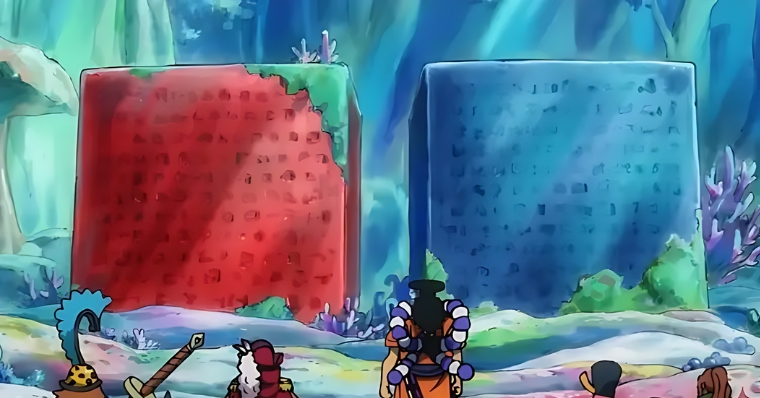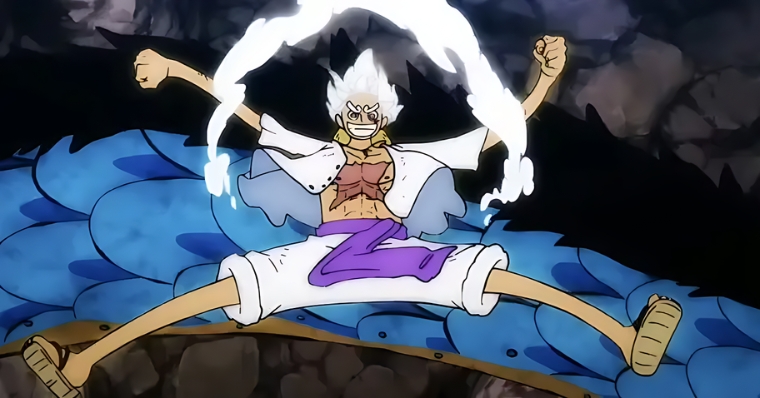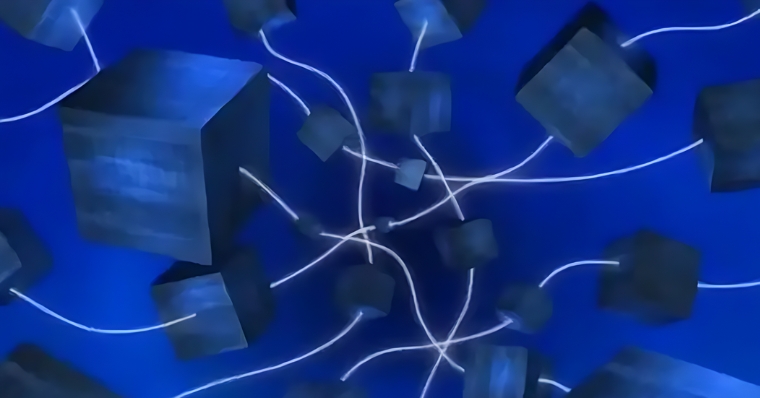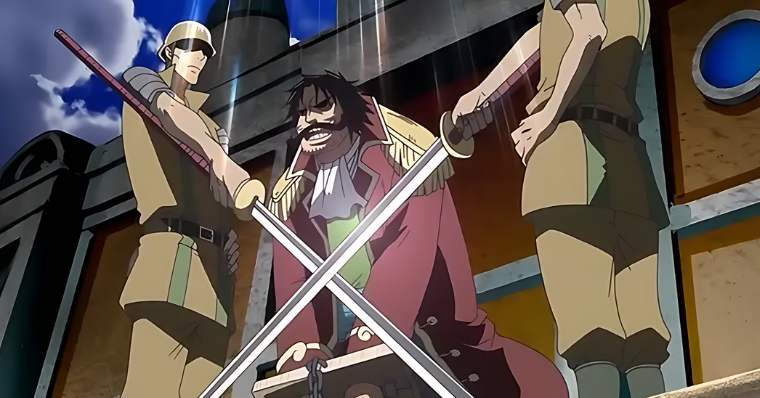If you’re a One Piece fan, you’re well aware that Eiichiro Oda’s sprawling universe is chock-full of riddles, enigmas, and clandestine corners that seem almost impossible to explore fully.
From the inception of the manga series over two decades ago, there’s been a magnetic pull of unanswered questions that have kept readers on their toes—clinging to each new chapter like it’s a life raft in the Grand Line.
And while the saga is entering its final chapters, we’re beginning to see some light shed on a few of these long-standing conundrums. However, let’s be real—some mysteries remain as elusive as the One Piece treasure itself.
So, without further ado, let’s delve into a list of eight gripping questions the series still has yet to answer, shall we?
What is The Great Kingdom?
The Great Kingdom—a term that has echoed in the minds of “One Piece” aficionados ever since Professor Clover first unraveled its cryptic name while delving into the Poneglyphs during Nico Robin’s tumultuous past.
Remember the suspense in the air? Yet, here we are, years down the line, still scratching our heads, trying to piece together the jigsaw puzzle that is this lost civilization.
Make no mistake, the Great Kingdom wasn’t just some forgotten territory; it was a marvel, a symphony of technological wonders that captivated even the imagination of Vegapunk, the genius who theorizes that the kingdom’s advancements could outstrip anything we know today.
This was a place so awe-inspiring that it rallied the Twenty Kingdoms—now known as the World Government—to join forces against it. And why did they unite? Well, my friends, therein lies the mystery.
Picture, if you will (Oh, I know, we can’t actually picture it—but bear with me), the Straw Hat crew sailing through Egghead, where remnants of this mythical technology still linger.
It’s as if history whispers through the rust and gears, yet the full picture remains maddeningly out of reach. There are gaps, voids, and information black holes that beckon for discovery.
You’d think after 800 years, someone would’ve cracked the code, right? But no. The Kozuki Family had the foresight to carve their history and messages onto the Poneglyphs—those near-indestructible monoliths that now serve as the only remaining breadcrumbs leading back to a world we barely understand.
In doing so, they passed on the heavy baton to future generations. A baton that still hasn’t crossed the finish line.
The World Government, for its part, has exercised extreme censorship. It has methodically expunged all information about the Great Kingdom like some Orwellian regime, banning any attempt to decipher the Poneglyphs.
Why? Because the “existence and idea of this kingdom present a threat,” as they say. But a threat to what exactly? Their global monopoly? Their historical narrative? The question, my friends, echoes in the grand halls of the Five Elders.
The kingdom is also somehow tied to the creation of the three Ancient Weapons capable of apocalyptic levels of destruction.
Were the Great Kingdom’s citizens the original architects of these doomsday devices? And if so, for what purpose were they built?
Our man Clover believed that the kingdom’s name itself could unlock the secrets of the Void Century, but a bullet silenced him forever before he could utter it.
It’s a labyrinth of intrigue so complex it could rival the Grand Line itself. The tale of the Great Kingdom is a murky stew of gaps, contradictions, and half-revealed truths.
We’ve caught glimpses, sure, but the full panorama remains elusive. As the final arcs of “One Piece” approach, the anticipation to solve the puzzle of the Great Kingdom has reached fever pitch.
Will we ever learn the full story? Only time and Eiichiro Oda’s pen can tell.
What is Imu’s True Identity?
If you’re following the sprawling epic that is “One Piece,” you’ve probably heard of Imu—the shadowy character who’s declared as the king of the world, casually lounging on what’s known as the Empty Throne.
The real kicker? Imu is the puppeteer pulling the strings behind the World Government, using the Five Elders as mere smoke and mirrors to keep their own existence hush-hush.
Despite Imu’s weighty influence on the World Government and, by extension, the One Piece universe, we’ve barely scratched the surface of who this character truly is.
All we’ve got so far is a silhouette—a faceless figure lurking in the background. What’s more, the character has knowledge dating back hundreds of years.
Some fans have even theorized that Imu has been around since the inception of the World Government, but right now, it’s a swirling cloud of question marks surrounding Imu.
Imu’s existence is kept so secretive that not even the highest echelons of the World Government dare to spill the beans.
You could say the mystery shrouding Imu is woven tighter than the threads of their extravagant robe, which seems to go on for miles.
Debuting during the Levely Arc, Imu has been a pivotal background figure, the over-arching antagonist maneuvering the narrative chessboard.
Yet despite the secrecy, Imu has some peculiar fascinations—like an unusual interest in key players such as Monkey D. Luffy, Marshall D. Teach, Shirahoshi, and Nefertari Vivi.
They keep wanted posters or photos of all four, showing a blend of calmness and calculated intent.
While the Five Elders might show hesitation before pushing the “obliterate” button, Imu doesn’t bat an eye. Their callousness is evident, annihilating entire islands just to erase them from the history books. Remember the destruction of the Lulusia Kingdom?
That wasn’t a random act of malevolence; it was a field test for an experimental weapon known as the “Mother Flame,” as if the lives lost were just variables in an equation.
The secrecy enveloping Imu isn’t bulletproof, though. They’ve revealed themselves to select people, like Nefertari Cobra when he probed too deeply into forbidden history.
Unfortunately for Cobra, the revelation was a one-way ticket with no return.
As for their abilities, the jury’s still out. The fact that Imu sits on the Empty Throne speaks volumes—symbolizing a reign over the entire world.
Yet Imu prefers to act through proxies like the Five Elders, almost like they’re safeguarding an arsenal of abilities yet to be revealed.
One thing’s for sure: their power is not to be taken lightly. Imu has ordered the use of the “Mother Flame,” a weapon of devastating magnitude, capable of erasing an island from existence within seconds.
Imu isn’t just a shadow lurking in the dark; they’ve shown the ability to transform into a hulking, beast-like entity, boasting fire-consuming capabilities and a wicked appendage or tentacle used for impalement—strong enough to injure even the Logia user Sabo.
Are we talking about a Zoan-type Devil Fruit power? Who’s to say?
And let’s not forget that Imu carries a saber—yet another puzzle piece that hasn’t found its place in the grander picture. While it hasn’t been unsheathed in battle, it’s been used in a more symbolic manner: cutting apart wanted posters and photographs.
In the grand tapestry of “One Piece,” Imu is an enigma wrapped in riddles, covered in mystery, and so far, no one’s managed to unravel the knot.
But, as the chapters unfold, we’re sure to uncover more layers that bring us closer to the truth of who—or what—Imu really is.
How Blackbeard Has More Than One Akuma No Mi?
In the labyrinthine world of “One Piece,” one enigmatic pirate sails miles ahead of the rest in terms of pure, mind-bending mystery—Marshall D. Teach, better known as Blackbeard.
He began as a mere apprentice in the crew of Whitebeard but gradually unveiled himself as a veritable Pandora’s box of paradoxes and puzzles.
His rise to infamy was lightning-fast and dramatically head-turning, especially when he did the unthinkable: wielding not one but two Devil Fruits or Akuma no Mi.
The first of these formidable powers is the Yami Yami no Mi, the ominous Dark-Dark Fruit that turns him into a swirling vortex of darkness.
But, just when you think you’ve got him figured out, he throws another curveball. He also wields the seismic powers of the Gura Gura no Mi, once the possession of none other than Whitebeard himself.
This isn’t just unprecedented—it’s game-changing. The established law in the “One Piece” world is clear: you can only have one Devil Fruit.
Dare to eat a second, and you’re signing your own death certificate. Despite fan theories galore, we’re still in the dark about how Blackbeard managed to break this unbreakable rule.
Several fascinating theories have tried to unravel the enigma that is Blackbeard. Among them is the captivating Cerberus Theory, suggesting that Blackbeard may have first consumed a Mythical Zoan Fruit—Dog-Dog Fruit, Model Cerberus—allowing him multiple heads, so to speak, to hold multiple Devil Fruits.
It’s a theory further enlivened by Blackbeard’s obsession with the number three—his Jolly Roger has three skulls, he uses a three-pronged weapon, and so forth. Intriguing? Absolutely.
Then there’s the Chimera Theory, which takes a somewhat biological approach. It posits that Blackbeard was born as a composite of multiple beings, thus allowing him to possess multiple Devil Fruits without croaking.
It’s a notion partially backed by in-series evidence, such as Marco the Phoenix noting the uniqueness of Blackbeard’s body structure.
Straying far from the multiple entities angle, the Tremor-Tremor Myth centers on the sheer power of the Dark-Dark Fruit.
This theory postulates that it’s not about how many entities reside in Blackbeard; it’s about the singularity of his original Devil Fruit’s abilities.
With its earth-shattering prowess, the Gura Gura no Mi is an enticing trophy for someone whose first Devil Fruit already allows him to nullify other Devil Fruits with just a touch.
Vegapunk Effect Theory, another entrant in this whirlpool of speculation, proposes that the enigmatic Dr. Vegapunk had a hand in tweaking Blackbeard’s biological makeup to house multiple Devil Fruits.
The plausibility of this theory is still debatable, given the minimal information available about Vegapunk’s whereabouts and Blackbeard’s early life.
And for those with a stomach of steel, there’s the grisly Cannibalism Theory. This idea suggests that Blackbeard obtained the powers of the Tremor-Tremor Fruit by consuming part of Whitebeard’s corpse.
Dark and unsettling? For sure. But in the unpredictable seas of “One Piece,” no theory can be entirely ruled out.
In essence, Blackbeard remains a tantalizing riddle wrapped in a mystery inside an enigma. Whether he’s a single individual with an extraordinary body or multiple beings coexisting in one shell, or whether his Devil Fruits are a result of scientific tinkering, dark arts, or something even more sinister.
One thing is certain: Marshall D. Teach has set the “One Piece” world alight with speculation, and fans are hooked, awaiting the revelation that could flip everything upside down.
What Happened in Void Century?
The Void Century is that tantalizing, elusive mystery that One Piece dropped on us almost from the get-go. It’s like the narrative version of buried treasure; right there, but oh so out of reach.
Spanning a hushed-up period of 100 years that the World Government has strictly forbidden anyone from researching, the Void Century potentially holds the keys to an array of world-shattering secrets.
We’re talking critical stuff here—like what actually transpired during the war between the enigmatic Great Kingdom and the founding fathers of the World Government, those initial 20 realms.
Then there’s the mind-bending issue of the real purpose behind those Ancient Weapons. And who knows? The century might even hold the answers to a myriad of other questions we haven’t even thought to ask yet.
Here’s the kicker: As Luffy and his crew of misfit pirates, known to fans as the Straw Hats, edge closer to the narrative finish line, the shroud of secrecy surrounding this verboten century is also becoming increasingly threadbare.
All signs point to impending revelations that could blow the lid off of, well, everything.
But let’s pull back a bit and zoom out. For those not familiar with the overarching scope of the Void Century, we’re talking about a gaping hole in the world’s timeline that’s roughly situated between 900 and 800 years before the Straw Hats set sail.
It’s like a black spot on the map of history, largely thanks to a censorship blitzkrieg launched by the World Government themselves.
Coincidence? Well, those in the know think not, especially when you consider that the World Government’s formation suspiciously coincides with the end of this cryptic period.
Throughout the Straw Hats’ maritime odyssey, nuggets of information concerning the Void Century have surfaced from a motley crew of sources.
These range from salty old seadogs who once sailed with Gol D. Roger to isolated civilizations like those found on Wano and Skypiea.
Even the Poneglyphs, those ancient stone tablets, chip in with their two cents, although the art of deciphering their archaic language is nearly extinct, courtesy of a rather unfortunate event known as the Ohara Incident.
But fear not! Thanks to the survival of Nico Robin and Kozuki Sukiyaki, there’s still hope that the annals of time etched in the Poneglyphs won’t be lost to oblivion.
So, why does all this matter? The pursuit of One Piece isn’t just a treasure hunt. It’s more like an epic quest to unearth the unvarnished history of the world, a crusade against the World Government’s oppressive rule aimed at setting the scales of justice back in balance.
And you can bet your last doubloon that the Void Century is a critical piece of that historical puzzle.
As we eagerly flip through the latest chapters of Eiichiro Oda’s magnum opus, it’s becoming increasingly clear that we’re on the cusp of revelations that promise to be nothing short of revolutionary.
Trust me, you don’t want to miss what’s coming up next.
What is Monkey D. Dragon’s Past?
Monkey D. Dragon, who holds the triple titles of Luffy’s father, Garp’s son, and leader of the revolutionaries, has been an elusive figure since his initial appearance in the early arcs of “One Piece.”
While we’ve gathered snippets of information, we still don’t know a ton about him—like opening a puzzle box and finding only a handful of the pieces inside.
The man is one of the World Government’s most-wanted, but what’s the real deal with him?
While we’ve gotten hints about the monumental event that led him to spearhead the Revolutionary Army, it’s still like reading the back cover of an epic saga and realizing you’re missing the entire novel.
His past remains shrouded, and the extent of his powers—particularly his Devil Fruit abilities—is almost criminally undisclosed.
As his revolutionaries continue to make cameo appearances throughout the One Piece saga, it’s like the universe is telling us that the floodgates of knowledge about Luffy’s dad are about to burst open.
Now, let’s get some context for those needing a refresher. Dragon, also renowned as “The World’s Worst Criminal,” has a lineage that would make anyone do a double-take.
His father is Marine Vice-Admiral Monkey D. Garp, and his son, as the world knows, is Monkey D. Luffy.
He’s not just any run-of-the-mill revolutionary; he’s the commander-in-chief of a force aiming to overthrow the notorious World Government and obliterate the Celestial Dragons from existence.
To say he’s stirring the pot would be an understatement.
When Dragon popped up in the Loguetown arc, he was more or less a stranger, a face in the crowd. It wasn’t until later, when Garp spilled the beans in Water 7, that we realized this stranger was no less than Luffy’s own father.
Dragon isn’t just some guy with a cool tattoo; he’s a mastermind with a deep-seated enmity against the Celestial Dragons, and he leads the Revolutionary Army, an organization so formidable it keeps the World Government on its toes.
Dragon grew up in the Goa Kingdom, raised by the so-called ‘Hero of the Marines,’ Garp. Little did Garp know that his son would grow up to be a sort of anti-hero, eschewing a life in the Marines to give voice to the voiceless and justice to the downtrodden.
Dragon’s history seems tangled up with his disdain for the abusive power structure in the Goa Kingdom, something we can only hope will be more deeply explored as the series progresses.
Flashbacks, courtesy of Dr. Vegapunk, reveal Dragon initially led an organization called the Freedom Fighters, a precursor to the Revolutionary Army.
Money was tight, but the mission was clear: liberation. Over the years, his evolution from a leader of ragtag freedom fighters to the supreme commander of a revolutionary force has been nothing short of awe-inspiring.
And let’s not forget the elephant in the room—or rather, the Buster Call on Ohara that triggered Dragon’s metamorphosis into a full-fledged revolutionary.
Then, he banded together with Bartholomew Kuma and Emporio Ivankov to form what we now know as the Revolutionary Army.
This alliance has since grown into a force significant enough to become the focal point at the Reverie, marking Dragon as “The World’s Worst Criminal.” Not bad for a guy who had to initially convince people to join his cause, right?
Dragon’s posse includes a roster of powerhouses. You’ve got the Revolutionary Army Commanders—Bello Betty, Karasu, Morley, Lindbergh—each leading their respective armies.
And who stands right next to Dragon? None other than Luffy’s charismatic older brother, Sabo, also known as the Flame Emperor.
Sabo has become a sensation in his own right, especially after being falsely accused of Cobra’s murder.
All of these characters are woven together in a tapestry that’s bound to become even more intricate. With “One Piece” careening toward its final chapters, we’re all bracing ourselves for some earth-shattering revelations about Dragon and his Revolutionary Army.
Their plans to overthrow the descendants of the 20 Kings and dig up long-buried secrets about the Ancient Kingdom are coming to a crescendo.
The questions are many, and the answers are few, but one thing’s for sure: Monkey D. Dragon is a character we’ll be talking about long after the final chapter is written.
Who is the Enigmatic Joy Boy?
Within the intricate tapestry of One Piece’s universe, one name has consistently loomed large, veiled in mystery: Joy Boy.
This enigmatic figure was first alluded to when Nico Robin took a gander at the Ryugu Poneglyph in the Sea Forest. But what really piques curiosity is how this name has recurred throughout the narrative, taunting us yet revealing so little.
In the lore of One Piece, Joy Boy’s relevance is undeniable. Mention of his name first graces us during Nico Robin’s trip to Fish-Man Island, where she reads an ancient Poneglyph.
The text implies that Joy Boy held some monumental significance during the elusive Void Century and left behind an artifact of insurmountable value on the last island of the Grand Line. A name etched into antiquity, you might say.
As if this didn’t tantalize fans enough, recent events have thrown us another curveball. In an adrenaline-fueled moment where Luffy unleashed his Gear 5, his Devil Fruit awakened, and then—wait for it—Zunesha claims that Joy Boy has returned.
It’s as if the universe conspired to drop a breadcrumb, linking Joy Boy’s enigmatic existence to Luffy, our intrepid protagonist.
Just like other unresolved secrets in One Piece, the mystery of Joy Boy promises to unfurl as more Poneglyphs are discovered.
But let’s not skip over some striking details. The Ryugu Poneglyph that Nico Robin read has also been interpreted as a letter of apology to the Fishmen.
Interesting, right? On top of that, Gol D. Roger, the Pirate King himself, once expressed his desire to live during the time of Joy Boy after discovering the true history of the world at Laugh Tale.
If we’re adding more fuel to the fan-theory fire, it’s notable to consider the shadowy suppression of Joy Boy’s existence by the World Government and the Gorosei.
Here comes a theory that’s almost as exhilarating as a high-seas adventure: What if Joy Boy isn’t a person at all but a mantle?
A symbolic title that adorns anyone committed to freeing the world from tyranny? This theory gained traction when King speculated that Kaido might fit the Joy Boy profile, only to retract that thought when Luffy stepped into the frame.
This idea was given credence during the Wano arc. Zunesha announced, hearing the “Drums of Liberation” again, a sound directly linked to Luffy’s heartbeat and his awakened Devil Fruit.
But wait, there’s more! The narrative shifts to the Gorosei, unveiling a major bombshell: Luffy’s Devil Fruit isn’t just any fruit; it’s the Mythical Zoan-type, the Hito Hito no Mi: Model Nika.
Those wielding its power are said to embody unparalleled freedom, limited only by their imaginations. If that isn’t a perfect alignment with the freedom-centric themes of One Piece, then what is?
To synthesize this whirlwind of information, we unearth two critical revelations: Luffy is not Joy Boy reincarnated. Instead, “Joy Boy” appears to be a role or title granted to those with the liberation mojo.
Second, the original Joy Boy, the one shrouded in centuries of myth and lore, was the first possessor of the Hito Hito no Mi: Model Nika.
When Zunesha, who’s been around for a few centuries, senses the awakening of this particular Devil Fruit, it equates that power with the presence of its long-lost ally, Joy Boy.
The unveiling of Joy Boy’s identity complements One Piece’s deeply ingrained narrative themes, such as inherited will.
Fans who once speculated that Luffy could be a reincarnation of Joy Boy can take a sigh of relief. This disclosure serves to amplify the continuous thread of inherited will through generations, a storyline that’s been masterfully laid out over 900 years in One Piece’s rich history.
As we eagerly await the final saga, the specter of Joy Boy continues to haunt the series, suggesting even more revelations concerning this legendary figure and his cosmic interplay with the World Government that has been desperately searching for his Devil Fruit for centuries.
What Caused the Poneglyphs to be Separated Around the World?
In the One Piece universe, there’s a shroud of enigma surrounding the Poneglyphs—these arcane monoliths etched with nuggets of forgotten history.
Recent chapters in the manga have pulled back the curtain a smidge, revealing not only who masterminded Nefertari Cobra’s demise but also some hush-hush details about the World Government and Nefertari D. Lili, the enigmatic queen of Alabasta.
Contrary to the tales spun in Alabasta’s annals, Queen Lili never actually made it back to her homeland. If that twist doesn’t grab you, consider this: the character Imu also dropped a breadcrumb, suggesting that these Poneglyphs were originally destined to remain hidden in Mary Geoise.
Yet, for some elusive reason, they ended up scattered like cosmic breadcrumbs across the world. And what’s more tantalizing?
The dispersal of these mystic stones appears to be intimately linked to Queen Lili. So, it’s not a wild leap to think that unveiling her hidden past might just solve the puzzle surrounding the wayward journey of these Poneglyphs.
The Poneglyphs are no ordinary slabs of rock. Crafted with expertise that defies even time, they are indestructible testaments to history, impervious to even explosions.
Thanks to ancient Kozuki stonemasons from Wano Country, these artifacts have survived the eons, virtually undamaged.
While they serve as treasure maps to an extent—guiding certain individuals toward their fate at the Final Island, Laugh Tale—they also hint at dangerous knowledge, like the location of three Ancient Weapons: Pluton, Poseidon, and Uranus.
Their existence poses an affront to the World Government, which has gone to great lengths to eliminate anyone capable of decoding their messages.
Nico Robin, a member of the Straw Hat Pirates and an Ohara survivor, is the last known person who can interpret these archaic inscriptions.
Yet, despite being in the World Government’s crosshairs, she’s not the sole key to unlocking these mysteries.
The legendary pirate Gol D. Roger also had this unique skill, leading him to unearth the deeply buried truth of the Void Century.
It’s a revelation so momentous that even Silvers Rayleigh, Roger’s former crewmate, warned that the comprehension of such knowledge might vary depending on one’s worldview.
So, when Eiichiro Oda, the mastermind behind One Piece, introduced us to these monumental rocks in Chapter 202 of the manga during the Alabasta arc, he wasn’t just adding another layer to his sprawling narrative.
He was sowing the seeds for an intricate yet tantalizing lore that would span chapters and arcs. While the anime got a bit ahead of itself, giving us a sneak peek in Episode 123 and even sneaking a Poneglyph into a filler episode, it’s clear that these inscrutable stones are not just plot devices.
They’re essential puzzle pieces in One Piece’s sprawling, intricate tapestry.
These steles come in flavors. The Historical Poneglyphs share pieces of a history long forgotten, while the Instructional Poneglyphs are more like tour guides, pointing the way to other Poneglyphs.
Then we have the Road Poneglyphs, the VIPs of this enigmatic ensemble. These ruby-red titans hold the coordinates to Laugh Tale, the final island of the Grand Line.
Secure all four, and you’re golden. They’re the most coveted, fiercely guarded by powers like the Four Emperors Charlotte Linlin and Kaidou.
And let’s not gloss over the Rio Poneglyph, a compendium of every other Poneglyph one would encounter on this grand oceanic odyssey.
It’s said to hold the sum total of the world’s real history, making it the Holy Grail of the One Piece universe. Intriguingly, this might not be a single monolith but a composite of nine different Poneglyphs.
So if you’re eager to get the complete lowdown on what exactly went down in this world’s storied past, your best bet would be to get your hands on all these singular stones and set a course for Laugh Tale.
All in all, the Poneglyphs are not merely historical artifacts; they’re woven into the very DNA of the One Piece world.
They’re riddles waiting to be solved, holding the keys to ancient powers, hidden histories, and perhaps even the fate of the world itself.
As we sail through each chapter, our curiosity swells like the tides. So keep your spyglasses handy because as we venture further into the Grand Line, the story surrounding these inscriptions will only get deeper and ever more fascinating.
What on Earth is the One Piece Treasure in the One Piece Universe?
Ah, the age-old question that has kept both pirates and fans sailing through chapters and episodes of “One Piece,” penned by Eiichiro Oda and serialized in “Weekly Shonen Jump” since 1997.
What exactly is the fabled One Piece? It’s the tantalizing treasure Gol D. Roger left on that elusive final island, a promise that has launched a thousand ships—or, you know, at least convinced Luffy D. Monkey and his Straw Hat crew to sail all over the Grand Line.
It’s not merely a pile of gold, mind you. That would be way too pedestrian for a tale as labyrinthine as One Piece.
From the get-go, fans have crafted theories galore about what lies at the end of this seaworthy rainbow. There’s even speculation that the island might be empty—a hypothesis author Eiichiro Oda has swatted down like a pesky fly.
We still don’t know which, if any, of these fan theories will pan out, but rest assured, Oda’s not leaving us high and dry. He promises that a grand revelation awaits us as the curtain falls on the Straw Hat Pirates’ odyssey.
Of course, let’s not kid ourselves. After an eye-watering more than 1000 episodes and 15 films, we’re no closer to knowing what’s in that treasure chest—or even if there is a chest.
It’s almost as if the universe is collectively conspiring to keep Luffy and the Straw Hats in the dark. Heck, they’re not alone.
Every single pirate on the high seas, from the fierce competitors to the World Government’s Marines, is scratching their head about this mysterious booty.
Yet, we’ve had some breadcrumbs. Sparse clues seem to suggest not just the treasure’s locale but possibly even its nature.
Diving into the treasure a little, or at least what we know of it: the Pirate King Gol D. Roger, captain of the Roger Pirates, was the man who amassed this enigma before meeting his Maker.
The treasure’s value is beyond measure and includes riches from a mystical dude named Joy Boy.
Considering One Piece’s recurring themes of friendship and the importance of the found family, some theorize that the treasure isn’t just heaps of gold and jewels but something far more intrinsically rewarding.
But before we could extract any more information from Silvers Rayleigh—Roger’s right-hand man—Luffy shut the whole inquiry down.
For Luffy, the allure of the One Piece is just as crucial to his pirate journey as the treasure itself.
And, oh boy, the theories. Some posit that this treasure trove houses the three ancient weapons—Pluton, Poseidon, and Uranus—which would make the World Government’s zealous prevention efforts make a lot more sense.
Imagine finding a historical document that not just vilifies the World Government but could dismantle it. Yeah, they’d rather you didn’t.
Others surmise it might spell the Red Line’s end, which would connect the entire world, essentially creating the One Piece. Get it?
Eiichiro Oda has always maintained a Sphinx-like silence, giving very little away. Though he has read fan theories, he tends to avoid them for a pretty solid reason—they’re often eerily accurate.
Concerning the One Piece treasure, though, he assured us it’s not some sentimental, sappy prize like the “journey was the reward” deal we’ve seen in stories like “The Wizard of Oz.”
As a storyteller who has spent over two decades on this series, Oda is vehement about fulfilling his narrative contract with his readers. If he’s promised an epic treasure, there shall be a treasure.
So, as we continue to ride the unpredictable waves of the Grand Line with Luffy and his crew, one thing remains certain: the answer to the One Piece treasure will likely be as labyrinthine and spellbinding as the story that has led us to it.
The One Piece treasure, shrouded in layers of mystery and decades of speculation, remains the ultimate question mark, a cipher that beckons us to keep sailing forward.
And you can bet we’ll be there, eagerly awaiting the moment when the puzzle finally unfolds, changing the One Piece world and perhaps our understanding of it forever.

